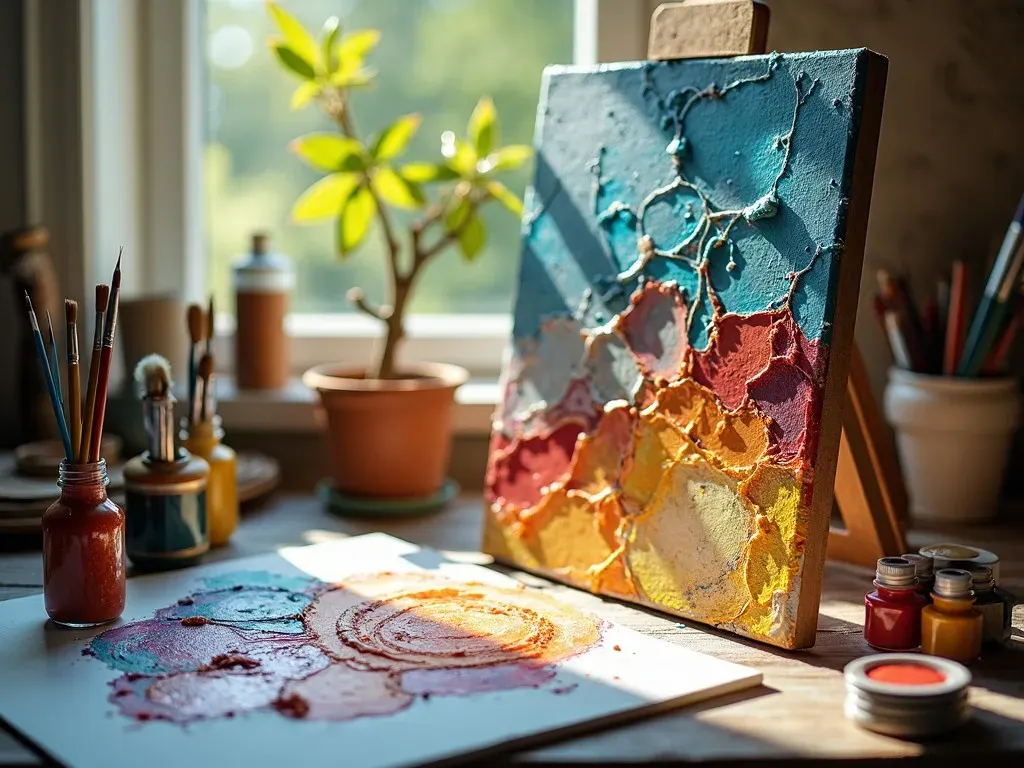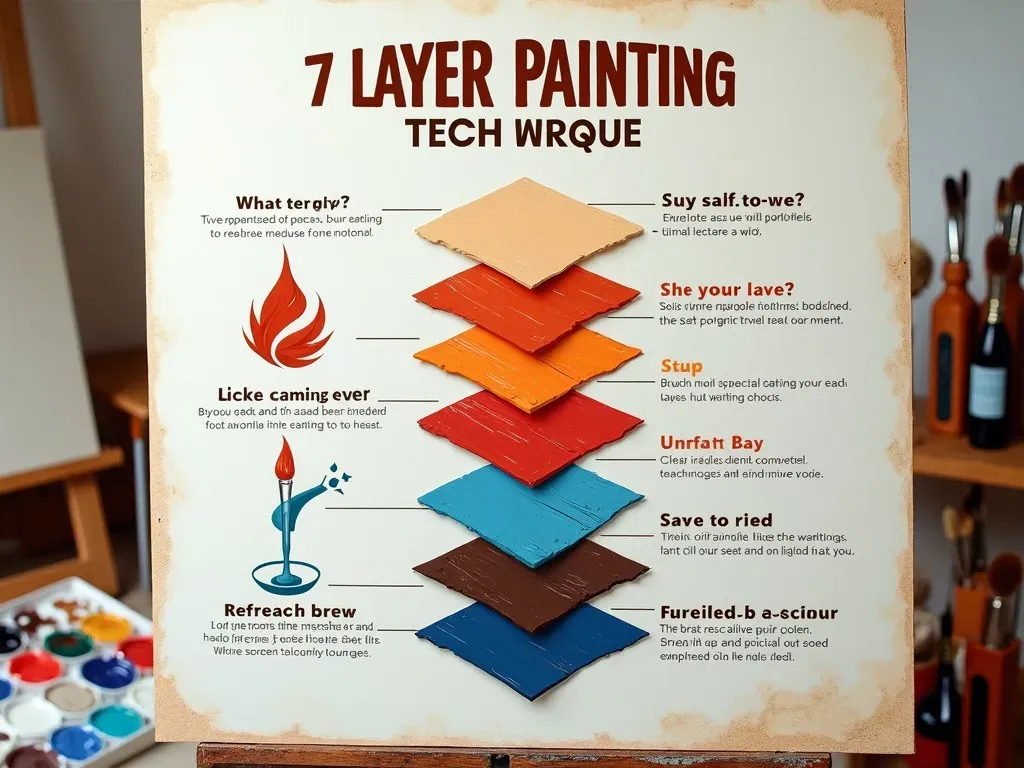The 7 layer painting technique—often referred to as the Flemish painting method or the Flemish technique—involves a meticulously structured approach to oil painting that consists of seven distinct layers. Each layer contributes to the depth, vibrancy, and luminosity of the final artwork. This technique, originating from the celebrated painters of the Northern Renaissance, allows artists to achieve realistic and deeply detailed compositions.
The Steps of the 7 Layer Painting Technique
The 7 layer painting technique can be broken down into the following steps:
-
Imprimatura: This is the first layer and usually a monochromatic warm base that will help to establish the tonal qualities of the painting.
-
First Umber Layer: A transparent layer of brown (often Burnt Umber) is applied to create a foundation for the painting.
-
Second Umber Layer: A second umber layer is applied to enhance the shadows and deepen the color.
-
Grayscale Layer (or Dead Layer): This layer is executed in shades of gray and helps to establish the values of the painting without introducing color.
-
First Color Layer: This layer introduces colors, which will begin to add vibrancy to the painting.
-
Second Color Layer: A second application of color is added, focusing on achieving the desired saturation and complexity.
-
Detailing Layer: The final layer where intricate details are added, often involving finer brushes for precision.
Facts About the 7 Layer Technique
| Layer | Purpose | Typical Drying Time |
|---|---|---|
| Imprimatura | Establishes a warm undertone | 1-2 days |
| First Umber Layer | Provides depth and contrast | 1-2 weeks |
| Second Umber Layer | Enhances shadow definition | 1-2 weeks |
| Grayscale Layer | Establishes values without color | 1-2 weeks |
| First Color Layer | Introduces color | 1-2 weeks |
| Second Color Layer | Adds vibrancy and saturation | 1-2 weeks |
| Detailing Layer | Final fine details and finishing touches | 1-2 weeks |
Understanding Each Layer in Detail
1. Imprimatura
The imprimatura serves as an initial layer that subtly influences the warm tones of the subsequent layers. Artists may use a color like yellow ochre or a burnt sienna to set the stage for their palette.
2. First Umber Layer
Applying this layer creates shadows and establishes the form of the subject. This layer should be allowed to dry thoroughly before proceeding, as it gives the artist a control point for managing dark tones.
3. Second Umber Layer
The second umber layer is critical for calibrating the tone. Here, artists can deepen shadows further by adjusting the thickness and opacity of the paint.
4. Grayscale Layer
Often referred to as the "dead layer," this application is typically composed of varying shades of black, white, and gray. This layer is essential for defining the light and dark areas of your painting, allowing a complete understanding of the form before injecting colors.
5. First Color Layer
Color begins to emerge in this step. Artists often rely on transparent colors that can allow some of the previous layers’ richness to shine through, contributing to the painting’s depth.
6. Second Color Layer
This layer solidifies the colors and introduces more complexity and variation. Techniques such as glazing can be utilized to enrich the color quality further.
7. Detailing Layer
In the final layer, artists focus on fine details that provide the painting with its photorealistic and intricate style. This can involve precise brushwork and layering of gloss or semi-gloss mediums to enhance highlights.

Advantages of the 7 Layer Painting Technique
-
Depth and Dimension: The multi-layer approach creates a three-dimensional effect, making the painting appear more alive and dynamic.
-
Color Vibrancy: Each layer contributes to the overall luminosity of the piece, allowing for a rich spectrum of colors.
-
Flexibility: Artists have the opportunity to adjust the tone and saturation at various stages, enhancing creative freedom.
-
Historical Significance: This technique roots artists in the rich history of oil painting, offering a method established by the old masters.
Common Mistakes to Avoid
-
Rushing the Process: It is essential to allow each layer to dry fully. Impatient artists rushing to the next step can compromise their painting’s integrity.
-
Skipping Layers: Omitting any step can lead to a loss of depth or tonal complexity.
-
Using Excessive Paint: Overly thick applications can obscure the luminance and glazing effects intended in the final piece.
-
Inaccurate Color Mixing: Understanding color theory is vital. Incorrect mixtures can lead to muddy colors when applied on the layers.
FAQs
Q1: How long should I wait between layers?
It is generally recommended to wait for at least a week between layers, although this varies depending on paint application methods and humidity levels.
Q2: Can this technique be applied with acrylic paints?
While the 7 layer technique originates from oil painting, similar processes can be utilized with acrylics, keeping in mind their faster drying times and differing application methods.
Q3: Do I need to be experienced to start?
While mastering the 7 layer technique can take time, beginners can certainly explore it. It is wise to start with simpler subjects and gradually increase complexity.
Q4: Where can I find more information on this technique?
For detailed tutorials and additional resources, you can visit EmptyEasel.com for comprehensive guides on the Flemish technique.
Q5: What materials do I need for the 7 layer technique?
Basic Supplies include high-quality oil paints, a variety of brushes, a palette, canvases, and mediums such as linseed oil or painting solvents.

In mastering the 7 layer painting technique, artists can recreate the stunning depth and detail of masterpieces, paving their path to becoming proficient oil painters. The patience and dedication required to navigate through each layer ultimately yield rich and captivating results. Whether you are a seasoned artist or a beginner, engaging with this technique is bound to advance your skills and deepen your appreciation for the art of oil painting.
